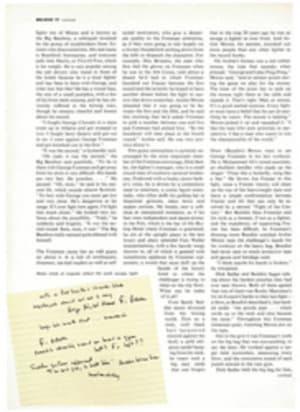
Oryx from unicorns grow
Only 10 years ago the Arabian oryx was erroneously reported extinct in the wild and was indeed so scarce that few authorities refuted the report. Today it has not only been rescued from what seemed inevitable extinction but it has been reestablished on a course toward survival.
The Arabian oryx is the smallest and most graceful of the four species of oryx in the world and the only one found outside Africa. A medium-sized antelope, it stands about 40 inches at the shoulder and has horns that grow up to 29 inches in length. When seen from the side, these horns often appear as one. So the unicorn may actually have been an oryx.
Until the last century the animal roamed in large numbers throughout the Middle East, insulated from man by the inaccessibility of its domain. Only the best hunters of a Bedouin tribe—those able and willing to endure long periods living on dried meat and camel's milk—attempted to overtake the oryx. This often entailed trailing the animal for days under the scorching desert sun. For many, the quest ended in death for the hunter rather than the hunted. The few who succeeded were lionized for their bravery, and the Arabs believed strength, endurance and virility were derived from eating the flesh of the oryx.
Unfortunately for the oryx, such beliefs persisted long after motor cars and machine guns replaced the camels and primitive weapons of the tribesmen. What had once been a test of hunting skill and stamina degenerated into mechanized massacre. In a few decades the oryx was systematically eliminated from Jordan, Syria, Iraq and the Sinai Peninsula, leaving only two wild populations in the world: one in the Nafud area of Saudi Arabia, the other farther south, in the Rub' al Khali (Empty Quarter).
By the '50s the northern population, too, was extinct, annihilated by oil-rich sheikhs and their guests who further streamlined the slaughter by adding airplanes and helicopters to their automobile armadas. In one 14-month period three separate raids, with hunters employing tommy guns fired from columns of several hundred Land Rovers, wiped out half of what was then believed to be the animal's total world population. In 1962 it was estimated that fewer than 35 wild oryx remained.
But it was these final decimations that helped save the Arabian oryx. When reports of the massacres reached Sanau Garrison, a fort about 250 miles northeast of Mukalla in Southern Yemen, the officials stationed there were so incensed that protests were immediately sent to London, where newspapers soon headlined the outrage.
"Desert Massacre to Please Harem," said The Daily Express in a colorful but unfactual account in which the paper attributed the slaughter to a raunchy desert chief out to boost his image and virility with the ladies of his harem. The Times and Daily Telegraph expressed more sedate concern and the Daily Mirror raised some $84,000 from its readers after a plea made in its pages by Naturalist Peter Scott.
"The Arabian oryx is probably the world's rarest animal," wrote Scott. "Anything that can be done to save it should be done at once. Probably the only answer is a Noah's Ark operation...capturing some and taking them to another part of the world where they can live in safety."
The indignation expressed in London spread to the Continent and then across the Atlantic. People on both sides of the ocean, including many who doubtless had never before heard of an Arabian oryx, rallied to the animal's rescue. The Fauna Preservation Society in London, for which Queen Elizabeth is patroness, proposed an expedition into the Empty Quarter to capture the remaining oryx for transplantation to a safer habitat. The Survival Service Commission of the International Union for Conservation of Nature and Natural Resources (IUCN) and the newly formed World Wildlife Fund backed the proposal.
In the U.S., Shikar-Safari Club International, probably the most distinguished and respected society of hunter-conservationists in the world, agreed to finance and sponsor the transfer and reestablishment of a breeding herd outside Arabia. Maury Machris, a Los Angeles oilman, was president of Shikar-Safari at the time Operation Oryx began.
"The world is changing too fast," Machris said, "to try to protect an endangered species by merely protecting its habitat. Too many factors, most man-created, upset the balance of nature in a wild reserve." He called the project "the most important example in history of international cooperation to save a single species of animal from extinction."
But before the Arabian oryx could be saved, it had to be caught. Ian Grimwood, chief game warden for Kenya, was chosen to lead a seven-man capturing expedition into the barren wastes of the Empty Quarter. It was a formidable assignment. Because of the climate and nature of the terrain, horses and dogs were ruled out as possible capturing aids. A special car—tough enough to withstand rough terrain, and large enough to take the animals aboard—had to be designed and built. Because so little was known about the oryx' tolerance for drugs, tranquilizers were ruled out in favor of old-fashioned cowboy-style lassos. Once caught, there was the problem of getting the animals out of the desert and then of where to put them.
One objective was to find a location as similar as possible to the oryx' natural habitat. The animals needed long-term protection so that they would have optimum chance to breed and increase to a point that might someday make it feasible to reintroduce the oryx into its native Arabia.
After months of consideration, it was finally decided that the climate and terrain of Phoenix, Ariz. were best suited for the animal's survival. Temporary or interim holding quarters were set up at Isiolo, Kenya. The East African Wild Life Society made a Piper airplane available to the expedition for spotting, and the RAF volunteered its services for transporting equipment into and animals out of Arabia. The governments of Kenya, Saudi Arabia and Kuwait, the U.S. Department of Agriculture, the Arizona Air National Guard and the Naples (Italy) Zoo all contributed in one form or another to the project.
"It is interesting to note," says Machris, "that American and European hunters played a vital and primary role in saving the Arabian oryx, although neither the animal nor its habitat had ever been a customary target for them. This preservation attempt stemmed solely from a genuine concern over a threatened species rather than from a possibly selfish desire to see the animals listed as one of the world's big-game trophy animals."
It is interesting, too, that the seven men on that original capturing expedition had among them virtually no specialized knowledge of the Arabian oryx or long-term interest in the animal. They were principally scientists—zoologists, botanists, a veterinarian—selected because of particular skills or talents they might lend to this unusual search.
The expedition moved into the Empty Quarter—a still comparatively unknown country—and began the search. Beset by sand, sun and heat, plagued by equipment breakdowns and frustrated by the elusiveness of the animal, the men began to question its very existence. But the determination of Anthony Shepherd, who wrote a book, The Flight of the Unicorns, about the adventure, and his associates finally succeeded in rescuing the first three animals that would become the World Pool of Arabian Oryx. Its numbers were swelled almost immediately by the contribution of a female, one of two oryx from the London Zoo. Encouraged by worldwide publicity, the sheikh of Kuwait donated a female from his private collection. Not to be outdone, the ruler of Saudi Arabia contributed two males and two females.
The first members of the World Pool were delivered by Shikar-Safari to The Phoenix Zoo in Arizona in the winter of 1963. On hand for their arrival were Maury Machris and a group of zoo officials. They had good reason for anxiety. There were few precedents for the raising of oryx. So little was known about the animal that even its gestation period was a mystery. And no one could be sure the animal would adapt to its new environment.
In its native desert, the oryx eats scrub vegetation with a nutritional content about equal to week-old clippings of Bermuda grass. It drinks about two ounces of water daily, extracted as moisture from leaves and plants. In the desert it is accustomed to temperature extremes ranging from 130° to freezing. Few forms of animal life exist in much of its environment, thus there are limited outside sources of infection.
Each day officials at the zoo recorded weather, temperature, food and water consumed and dozens of other related facts and observations about the new inhabitants of Phoenix. Except for large saguaros with spines clipped up beyond reach of the animals, all cacti were removed from the oryx enclosures, leaving only paloverde and ironwood trees and creosote bushes. Double fences with wooden boards at eye level were erected to give the animals greater security than chain link fences.
Water, provided in rubber buckets to prevent the oryx from injuring themselves, was carefully rationed because there was danger that the animals, unaccustomed to an abundant water supply, might overdrink and become ill. All food and equipment were sterilized to prevent introduction of foreign bacteria, and personnel admitted to the compounds were first required to dip their shoes in antiseptic footbaths.
Punching-bag-like sacks were put in some of the pens to give the animals a target other than zoo officials into which to hook their horns when feeling obstreperous, which was less and less often as the normally docile animals not only became acclimatized to their new environment but appeared to thrive. Several months after arrival, one of the females captured by the original Empty Quarter expedition produced the first World Pool dividend. The new calf weighed in at 17 pounds and answered one question: the gestation period of an Arabian oryx is 260 days.
This fact has been regularly substantiated in recent years as the herd at Phoenix grew from its original nine members to 36. Such increase is even more extraordinary when one considers that animals captured in the wild, although they will and often do breed in captivity, rarely produce progeny that breeds. As experience in conventional zoos has shown, the young, usually isolated from their parents from birth, have failed to acquire the normal behavior patterns of their species. But at The Phoenix Zoo the newborn oryx were left with their mothers in their simulated wild habitats. Zoo officials gambled that this would give the young an opportunity to learn the natural territorial patterns and herd life of their family group. The gamble paid off. All of the young born at Phoenix have bred upon reaching adulthood; in six cases both parents have been second generation.
"Total success," says Machris. "Until that happened, we couldn't say that we had really turned the corner."
With the transfer of six Phoenix animals to the San Diego Zoo this winter, Operation Oryx turned still another corner. Officials had long been concerned about the risks involved in concentrating all of the animals in a single locale. The danger, for example, of an epidemic disease wiping out the entire herd was ever present. Ten years ago Shepherd had hoped, but with little expectation, that the nucleus of another breeding herd might be established as insurance against possible disaster and also to permit eventual cross-breeding of the two herds to strengthen the strain and reduce inbreeding.
The day when the herds of oryx on this side of the world will be large enough to return to the wild deserts they once roamed is still far in the future, but the fact that there is any future at all is a dramatic example of international conservation on a grand scale.
TWO PHOTOS
THIS BABY ORYX, ONE OF MANY TO BE BORN IN THE PHOENIX ZOO, WILL SOON BE TOOTING ITS OWN HORNS LIKE ITS ELDERS

